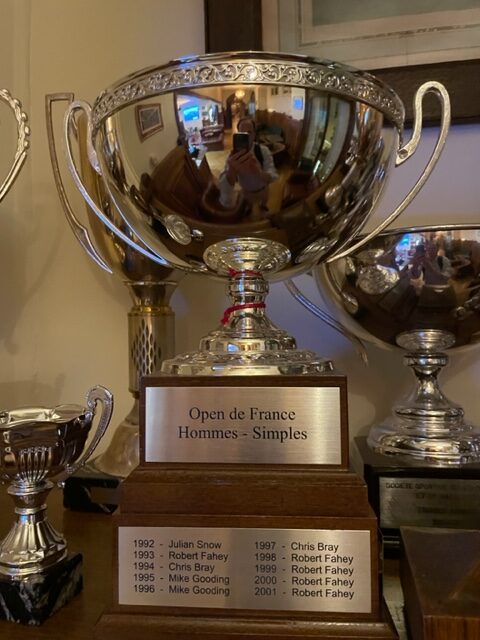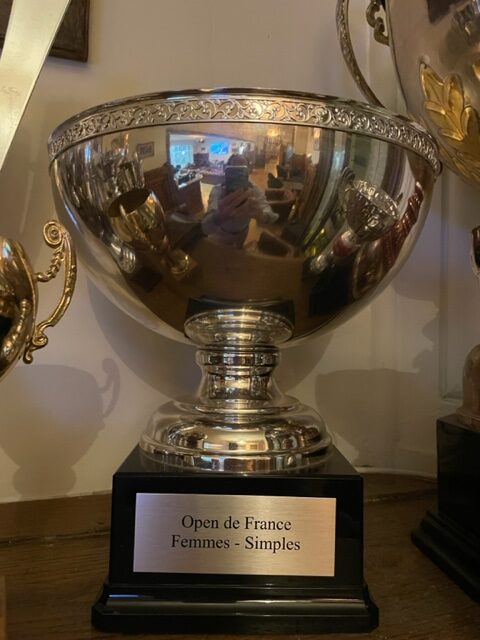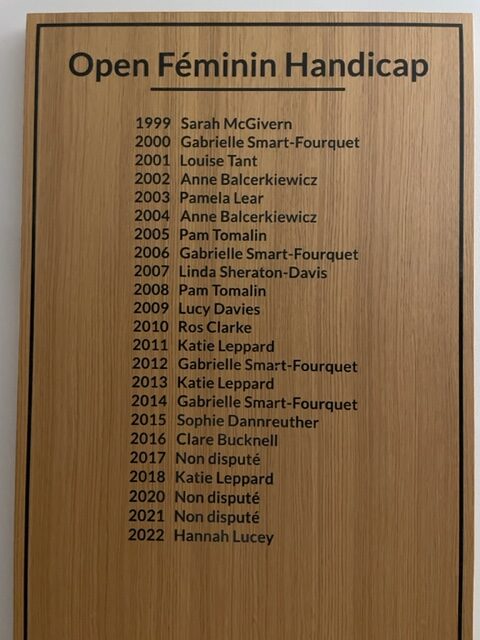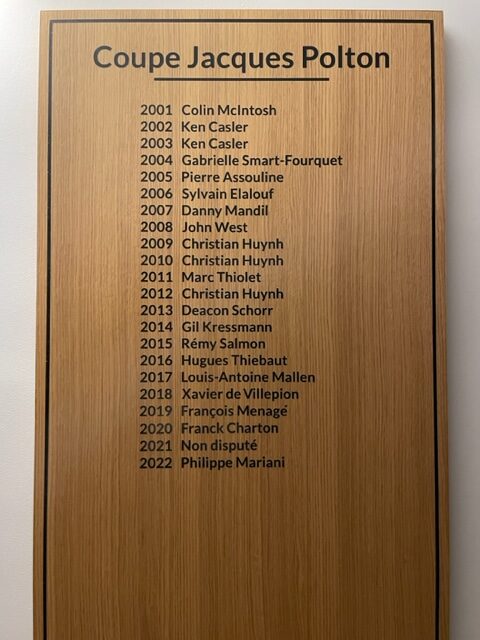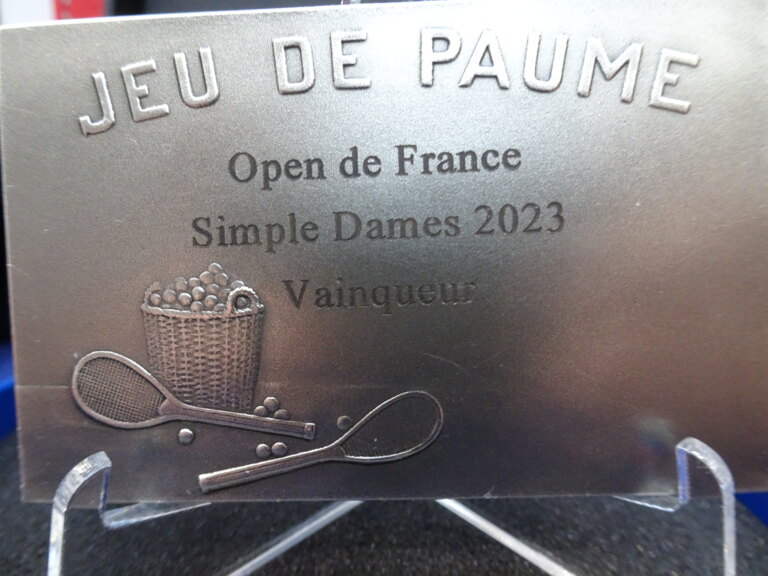A word from the chairman
'Jeu de Paume' is played in Paris, Fontainebleau, Bordeaux as well as on the courts of south-west France. Worldwide, the game is played in England, Scotland, Australia and the United States. Two old courts are currently being restored (Pau, Chinon) and new courts are being built: 1 in Australia and 2 in the USA.
Come and discover this unique community, its clubs and this fantastic sport.
See you soon on our courts!
Tim Batten - Chairman of the French Real Tennis Committee
The game of Real Tennis

Like the game of tennis from which it originated, real tennis, also known as jeu de paume, requires great sporting qualities: strength, speed, finesse, precision and skill. The main characteristic of this sport lies in its rules, first defined in 1592, which place great emphasis on strategy and tactics. At each exchange, there are numerous options for challenging the opponent.
Although France has long dominated this sport, with legendary figures such as Antoine-Henry Masson in the 18th century, Jacques-Edmond Barre in the following century and Pierre Etchebaster in the first half of the 20th century, the best players of the moment are Anglo-Saxon. Known as "real tennis" in the UK and Australia, it is also played as 'Court tennis' in the USA.
Early development period

By the end of the 16th century, Paris had 250 halls, while cities such as Orléans, Rouen, Angers, Lyon and Bordeaux sometimes had dozens of halls, proving the public's enthusiasm for jeu de paume.
This French sport, which spread throughout Europe from the Renaissance onwards, has inevitably left its mark on our country's heritage, history and culture. We need hardly remind you, for example, that it was in the Versailles hall on June 20, 1789 that the deputies of the Third Estate swore an oath not to separate until a constitution had been drawn up for the country.
The French language has also retained a number of expressions directly derived from the game of paume, which are best expressed in French, but when translated become "to impress the gallery", "to remain on the square", "to fall on one's face" or "who goes hunting loses his place".
But the real tennis is also :
- the first sport to introduce the notion of fair play during the Renaissance period: respect for one's opponent, self-control, moderation in speech, knowledge of one's limits. It's the perfect exercise for balancing body and mind, as the humanists and later Enlightenment philosophers wrote!
- the first racquet sport in history, it was first used in the 16th century.
- the first sport to be played by professionals, the "maîtres paumiers". From the beginning of the 17th century, the best of them regularly gave demonstrations to the Court and to ambassadors visiting France, who then went on to recount their exploits throughout Europe.
-the first sport which, from the early 18th century onwards, organized regular international challenges in which French peaceniks met their English counterparts, the beginnings of modern tournaments.
Principles of the Game
Like lawn tennis, real tennis is played in singles or doubles and consists of passing the ball back and forth over the net with a racket. Only one ground bounce is permitted. On the other hand, there are no limits on bounces off walls or roofs, which are used as key surfaces to play the game.
The ball must touch the roof of the gallery at least once and fall into the service box.
The 'chase' system, used in many games in the Middle Ages, has endured in Real tennis, where it determines when players change sides. If the ball bounces twice on the ground without the player having touched it, the location of the second bounce is marked by lines called chasses. This pending point is put back into play after the side change, and the scoring area is reduced between the back wall and the chase.

A player wins a rally and scores fifteen when the ball hits the grid, falls into the last open (called the bell) or ends up in the inside gallery. If the ball falls on its second bounce after the line marked with a D (corresponding to the last open) on the front side, the serving player scores a point. If a player makes a fault or sends the ball back into the center net, he gives a point to his opponent. The system of counting points by fifteen (15, 30, 40, advantage, game, set) has existed since the Middle Ages and has been adopted by tennis.
RULES OF THE GAME (in French, for EN, consult T&RA or USCTA sites)
HISTORY OF THE GAME (in french only as of today).. EN sources to be added
Tournaments (list and descriptions)

National Competitions
French Open
Proposed in 1976 by Laredo Masip
because the then-president of the French
Real Tennis Association, René Diani,
had forbidden professionals to play in
the Raquette d’Or and the Raquette
d’Argent. This tournament is open to
all French players, professionals and
amateurs
Gold Raquet (1e series)
Created in 1899, this competition is
now reserved for amateur real tennis
players with a handicap below 20 who
have been members of a club in France
for at least six months.
Silver Raquet (2e series)
Created in 1899 for players with a
handicap between 20 and 30
Bronze Raquet (3e series)
Created around 1970 at the suggestion
of Laredo Masip, for men and women
players with a handicap between 30
and 40. The creation of this tournament
led to a reorganisation of the handicap
classes
Brass Raquet (4e series)
Created around 1970 at the suggestion
of Laredo Masip, for players with a
handicap above 40, mainly attracting
those new to the game
Member Handicap
Created in 1920, this handicap
tournament is reserved for Lauriston
club members only. It is the most
important tournament open to members
regardless of level or handicap
National Champtionships
National Veterans Championship >50,
>55, >60 and >70 years
National Women’s Championship
National Juniors Championship <18
years
Championnat de France féminin
Championnat de France juniors (< 18 ans)
Paris Cup
This cup was created in 1910 and
paused at the outbreak of World
War II in 1939. Restored in 2018, it
is an invitational event played by the
Club’s top 16 players.
Bastille Cup
Created in 1989, it is to be played
at every Centenary of the French
Revolution in perpetuity
Jacques Polton Cup
Around 1985, the Bordeaux club created
the Trophée Édouard Kressmann in
honour of the real tennis player and
co-founder, with Claude Quancard, of
the Jeu de Paume de Bordeaux. The
cup, played in singles and doubles, is
reserved for players over 50.
In 2001, the Paris club took up the idea
and created the Jacques Polton Cup, a
handicap tournament open to players
over 50. Jacques Polton, a businessman
with a passion for real tennis, was still
playing well into his 80s. He gifted
the tournament a silver plate inscribed
with the names of the initial winners
Tuileries Cup
This event is organised by the head
professional for new players who have
been playing real tennis for less than
12 months
Thélème Cup
Created by Charles-Antoyne Hurstel
in 2017, this cup was first called the
Antoine-Henry Masson in memory
of the best player in the kingdom
of France in the 18th century. He
is also remembered for his role in
‘The Big Match’ in 1767 against the
Englishman Tomkins who lost in
5 sets. It is an International Open for
1st series players, primarily involving
players from the UK and Francee century. It was known as "The Big Match" in 1767 against the Englishman Tomkins, who was beaten in 5 sets. This tournament is open to players in France and England with a handicap of between 10 and 20.
International Competitions
World Championship
Played for the first time in 1740 in
Fontainebleau, the World Championship was won by the renowned maîtrepaumier Pierre Etchebaster from 1928
to 1952.
Both men’s and women’s championships are held every two years, in one
of four countries in rotation: Australia,
England, France and the United States.
The Men’s world champion is decided
by an elimination match pitting an able
challenger against the reigning world
champion. The reigning champion and
the challenger play a match of up to 13
sets over 3 days (4 sets, 4 sets and up to
5 sets if necessary on the last day). The
winner is the first to win 7 sets
International French Open
This Pro-Am tournament has hosted the
world’s best men and women players
since 1992. There is also a tournament
for juniors
Womens Handicap Open
This annual international tournament
was created in Paris in 1992. It rotates
between the three French clubs
(Bordeaux, Fontainebleau, Paris) and
brings together some twenty players
from Australia, England, France, the
Netherlands and the United States.
Bathurst Cup
Created in 1922 by Lady Lilias
Bathurst, owner of the Morning Post,
this tournament is to the game of real
tennis what the Davis Cup is to lawn
tennis.
Originally played every year, the cup
has been played every two years since
1992 between Australia, England,
France and the United States. The
tournament is reserved for amateurs
who play by nation (one nation one
team). Morning Post, this tournament is to real tennis what the Davis Cup is to lawn tennis. Formerly played every year, since 1946 this cup has been played every two years between England, Australia, the United States and France. The tournament is reserved for amateurs and is organised by national team.
Gould-Eddy Cup
Created in 1922 by Spencer
Eddy, the first president of the
Lauriston club, as a tribute to
Jay Gould, one of the best players
of the time. It is exclusively a
doubles competition
Other tournaments
Tournois de Noël
Dedanist Foundation vs. French Clubs
This English foundation founded
in 2002 offers scholarships to
young real tennis players aged
13 to 25 from disadvantaged
backgrounds
France vs UK
Initiated by Ivan Semenoff, this new
singles and doubles tournament,
reserved for French and English
players over 50, is held every two
years, alternating between France and
England
Taylor M. E. Baldwin Charity Cup
In 2015, the Taylor M. E. Baldwin Charity Cup was created to raise funds for the Fondation Saint-Jean-de-Dieu which cares for disabled children, including the son of a club member. All games are held in doubles format and played in a friendly atmosphere. The tournament is greatly appreciated by all players, regardless of level.
Trophée Edouard Kressmann
Played in honour of Édouard Kressmann, father of Gil Kressmann. The cup is played in singles and doubles and is reserved for players over the age of 50.
Small selection of books related to Real Tennis clubs in France
The History of the Jeu de Paume Club in Paris (published in April 2022)
available on:
– Ronaldson Publications
– Amazon.fr
Archeology & history of real tennis in France (published in May 2024)
– Amazon.fr

